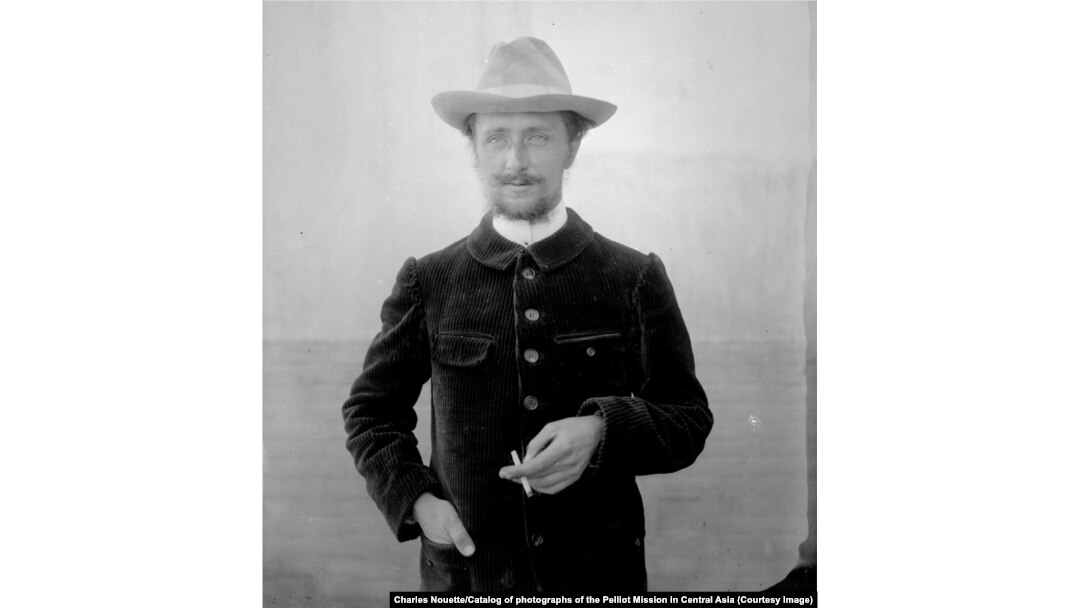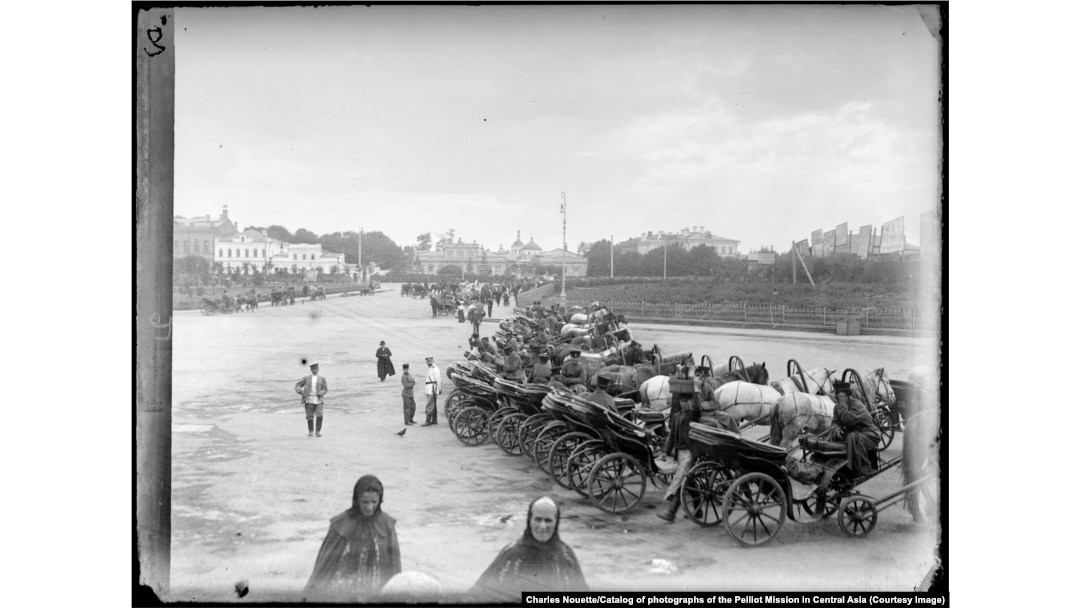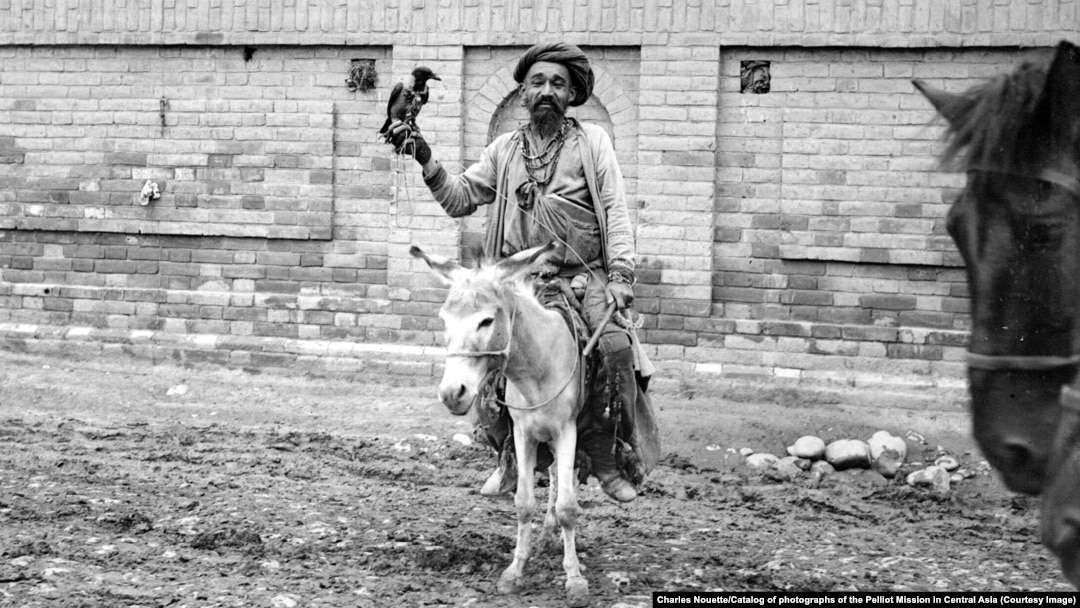As French explorer Paul Pelliot gathered supplies for a yearslong expedition through Russia and into Central Asia in 1906, he made sure he lacked for nothing.
Along with guns, canned meat, and tents, the Parisian packed 25 bottles of Coste-Folcher champagne and 30 kilograms of cognac.

Paul Pelliot (1878–1945)
The French quest came on the heels of similar Western expeditions into "Russian and Chinese Turkestan" to research -- and, in many cases, remove and ship back to Europe -- priceless artifacts of the ancient kingdoms and cultures that had once thrived in the region.
Pelliot's mission was unique for the superb images captured throughout the journey by photographer Charles Nouette. The photographs, numbering more than 1,500, were recently compiled by the Guimet National Museum of Asian Arts in Paris and published online.
Below are some of the most striking photos from the quest that offer a glimpse of Central Asia and imperial Russia on the brink of epochal change.

Horse-drawn cabs wait for customers outside a Moscow train station.
With the blessing of the imperial government in St. Petersburg, the French expedition departed Moscow for Samarkand, in today's Uzbekistan, in July 1906.
Russian troops returning from Manchuria at an unspecified location in June 1906
The Russian Empire at the time was being roiled by political upheaval following the 1905 revolution and war with Japan.
Locals swim in Tashkent. Two unidentified members of the French expedition (far right) watch the summer scene.
The French group explored Uzbekistan as they waited nearly a month for their tons of equipment and supplies to clear customs before they could travel east toward today's Kyrgyzstan.
A rare view of Registan Square, the historic center of Samarkand, filled with market stalls. Above the arch are the two iconic leopards of the Sherdor Madrasah.
Pelliot described Central Asia as a region "no less deeply mysterious than Central Africa" that was rendered newly accessible for Western explorers after "Russian weapons finally cleared the approaches."
A photo made soon after the expedition's arrival into today's Uzbekistan. The caption, "Old fool, Tashkent," hints at the disdain the group held for some locals.
This portrait of a man in Tashkent was captioned "Lepers."
Pelliot was chosen to lead the expedition partly for his linguistic talents. He spoke English, Russian, Turkish, and Chinese.
A view from the top of the Sherdor Madrasah over central Samarkand.
Extensive high-level negotiations between Paris and St. Petersburg had preceded the Pelliot expedition.
The expedition meets with local dignitaries at a camp in Osh.
In return for providing support and allowing access to Russian-controlled territory, St. Petersburg required that Pelliot (seated on right, above) took along Carl Gustaf Emil Mannerheim (with back to camera), then a young colonel in the Russian Army, as a spy to gather intelligence from Chinese-controlled regions.
In Samarkand, the expedition was furnished with an armed escort of five Cossacks (pictured) by the Russian state.
Pelliot warmed to the armed guard provided by the tsar.
"These Cossacks come with a good heart," he wrote. One adventure-hungry officer, he said, "wanted to join the expedition even at his own expense."
A street in Osh, with the city's iconic Sulayman Mountain in the background
The early months of the expedition were not successful in their stated goals of new archaeological discoveries.
Pelliot wrote to a colleague, "I might as well tell you right away that we haven't made any sensational discoveries here. Too many people have passed before us, the Japanese, the Germans, the Russians, who had taken control of everything that was easy to find and easy to grab."
A bride photographed during her wedding in the mountains of today's Kyrgyzstan
The wedding party next to their yurt
A farrier shoes a horse in Osh.
After months spent in the regions of today's Uzbekistan and Kyrgyzstan, the expedition crossed into China in late 1906.
Members of the expedition ride on horseback in Kashgar, western China.
Rocks bearing a phallic symbol and swastika in China
One of the expedition's accompanying Cossacks, named Ilyazov (center), during an evening of music in China
The expedition began to make fresh finds inside China as they uncovered remnants of ancient Buddhist culture, and, finally, thousands of Chinese manuscripts in a cave monastery -- the headlining discovery from the expedition.
A relief representing scenes from the life of Buddha in China's Xinjiang Province
A detail of the Xinjiang reliefs that once decorated a palace
The boxes of discoveries brought back to Paris by the expedition
The expedition was generally seen as a success, and Pelliot went on to have a distinguished career as one of the world's foremost experts on China and Central Asia.
Soon after the expedition was completed, photographer Charles Nouette died of tuberculosis aged just 41.


